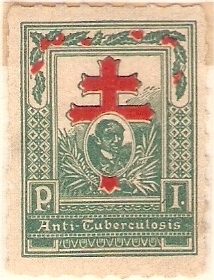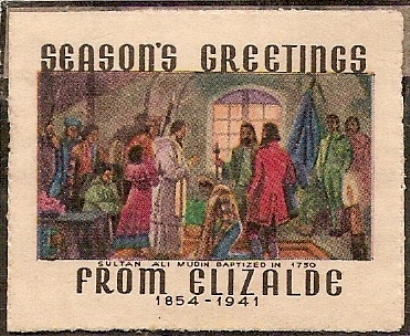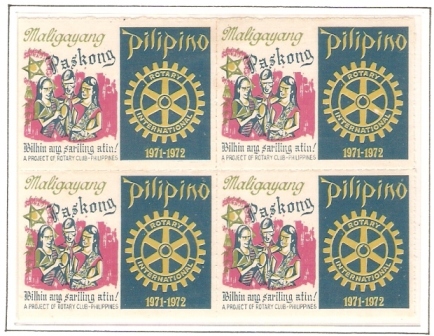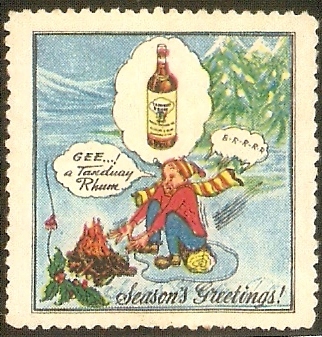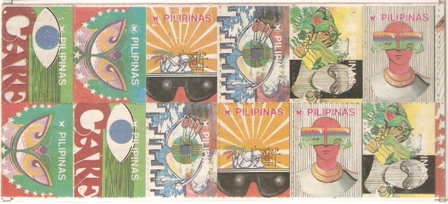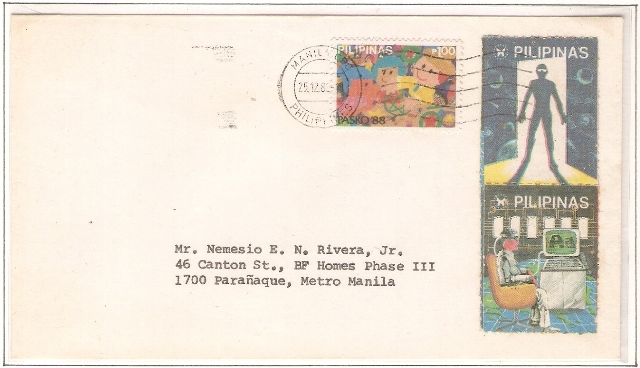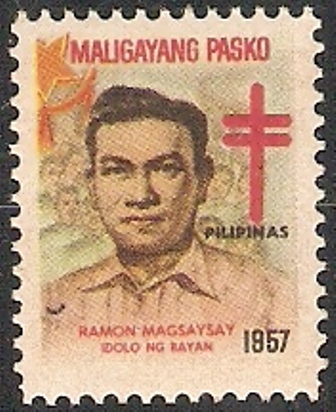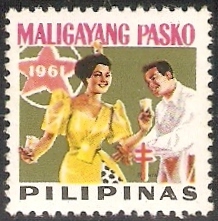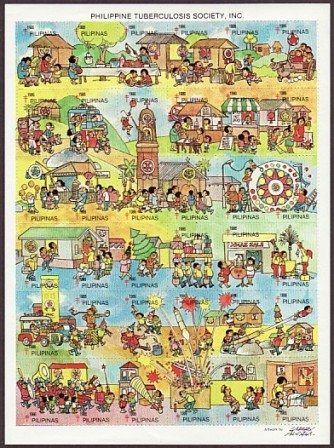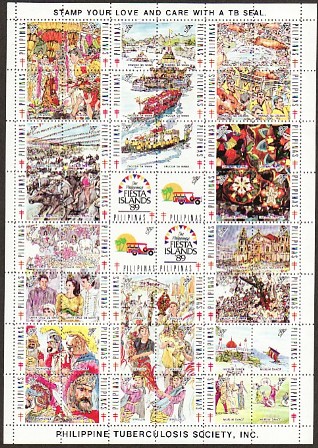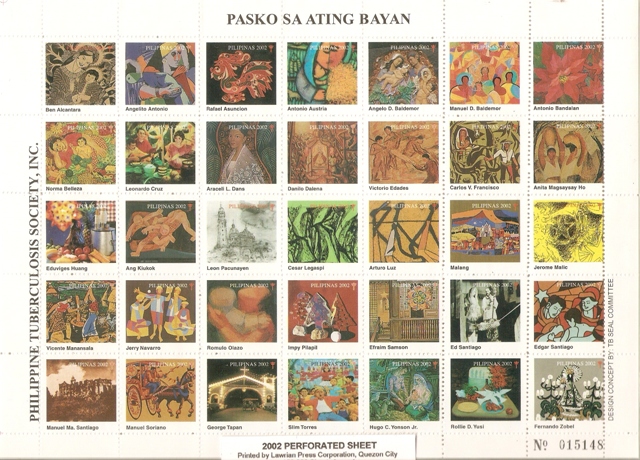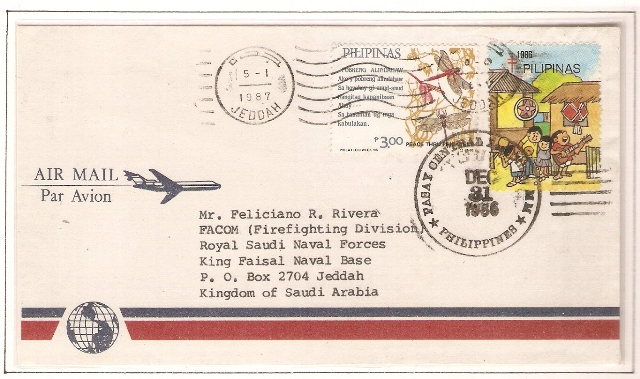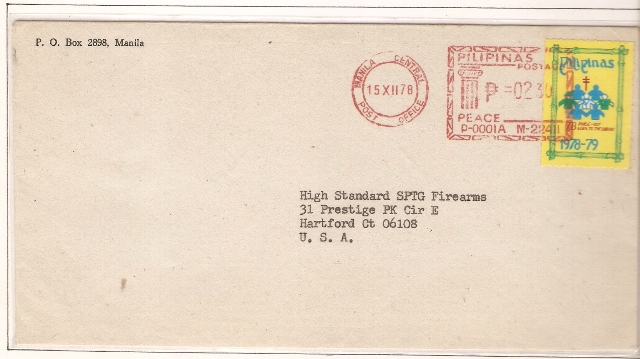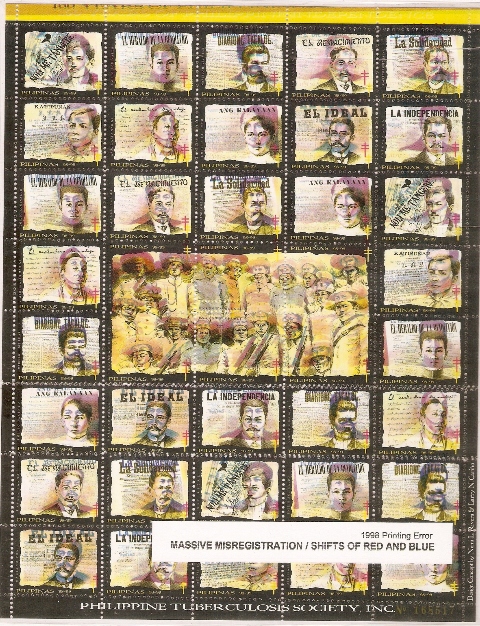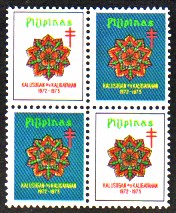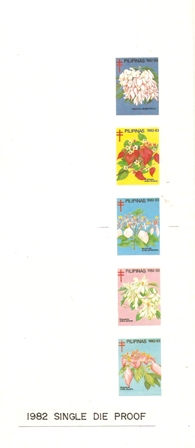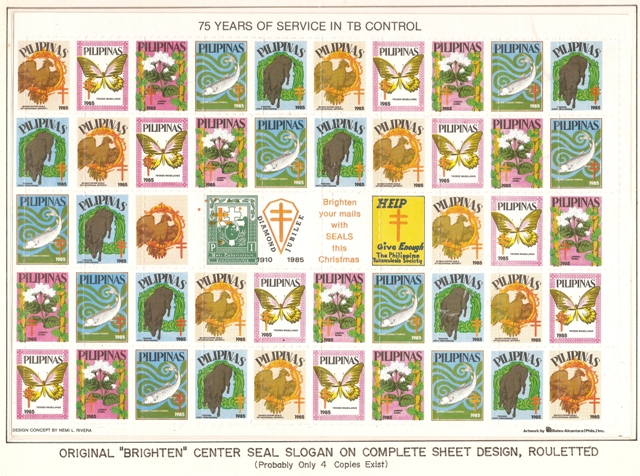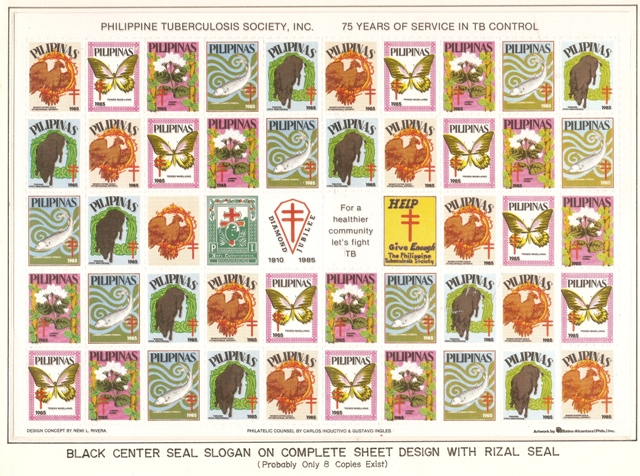-
Anti-TB Semi-Postal Stamps of the Philippines
-
Christmas Stamps of the Philippines
This is an updated version of previously published article. Nemy has done a marvelous job in updating the information and illustrations of seldom seen materials.
BEAUTY AND VALUES ABOUND
IN PHILIPPINE CHRISTMAS SEAL COLLECTION
By N. L. Rivera, Paranaque City, Philippines
A. PROVENANCE
Philippine Christmas seals are produced and sold every year by the Philippine Tuberculosis Society, Inc., a private organization founded primarily to combat tuberculosis. Thus, these seals are often referred to as “TB Christmas Seals”.
Figure 1 - 1910 First Philippine Christmas Seal
The Philippines’ first Christmas seal was issued in 1910. (Fig. 1) Thereafter there were intermittent issuances until 1947, when seals were regularly printed and released once a year towards Christmas.
Figure 2 - 1935 President Manuel L. Quezon Strip Seals
The now rare 1935 Quezon’s birthday strip seals, although strictly not a Christmas issue, are included in the Christmas seal collection because these are listed and illustrated in Green’s Catalog of Tuberculosis Seals of the World, together with all TB Christmas seals issued in the Philippines and around the world. (Fig. 2). This catalog is considered by many as the Bible of Christmas seal collectors.
The first three issues were printed in Manila. From 1947 to 1970, printing of these seals were largely done in the United States, except for some years in the 1960s when seals were printed in Japan. From 1971 onwards, seals were printed in the Philippines by various local printers.
As of 2008, there had been sixty-five issues of these “TB Christmas seals.”

Figure 3 - 1940-1941 Elizalde Christmas Seals
Elizalde & Co., an old and respected commercial company, issued its own private Christmas seals in 1940 and again in 1941. These were given away free to the public upon request. The 1940 design was drawn by National Artist Cesar F. Legaspi during his younger years. The Elizalde seals are among the very few non-TB Christmas seals and are an important entry in the Philippine collection. (Fig. 3.)
Figure 4 - 1971 Rotary Club Christmas Seals
In 1971, the Rotary Club of the Philippines issued its first ever Christmas seal, which secondarily promoted its “Buy Philippines” campaign. (Fig. 4). This is a truly Christmas seal issue, similar to the Elizalde seals, but due perhaps to its limited availability and low awareness among collectors, this seal, sadly, is not present in many Christmas seal collections.
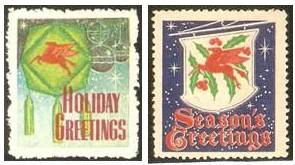
Figure 4a - Mobil Oil (2) and Tanduay Distillers Christmas Seals
After reading a draft of the article, a resourceful collector-friend, Capt. Roberto V. Araos of Quezon City, called and sent in three heretofore unheard of amazing non-TB Christmas seals. One was issued by Tanduay Distillers, the other two by Mobil Oil (?).(Fig. 4a.) These measured 32 x 34 mm. and 28 x 32 mm, all perf. 11. Unfortunately no other details were available. We shall be most grateful if someone who owns, or have access to these seals, can send us more information.
Figure 5 - 1988 Strip of 12 different FRPBP Charity Stamps
The Foundation for the Rehabilitation and Prevention of Blindness in the Philippines (FRPBP) made yearly issues of its charity stamps from 1987 to 1990. Because the Postmaster General in 1987 allowed the sale of these stamps thru postal windows, alongside the TB Christmas seals, some collectors mistook these for legitimate Christmas issues and tentatively mounted them in their albums. The FRPBP seals are generally poorly produced, but some se-tenant issues are unique and attractive. (Fig. 5 and 5a).
Figure 5a - 1988, December 25, Manila, Machine Cancelled
Regular postage stamp combined with a pair of FRPBP charity stamps
B. CONCEPTS, THEMES AND DESIGNS
After the first three issues, the early Christmas seals hewed to traditional Christmas themes - of Pilipino families preparing for and celebrating Christmas. The Nativity was symbolized by several versions of Mother and Child.
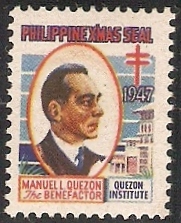
Figure 6 - 1947 President Manuel L. Quezon
Figure 7 - President Ramon Magsaysay
Two Philippine presidents were singularly honored on Philippine seals: the fiery and colorful Manuel L. Quezon, first President of the Philippine Commonwealth was portrayed in the seals of 1947 (Fig. 6); and the supremely popular “idol of the masses” Ramon Magsaysay was featured in the 1957 seals. (Fig. 7).
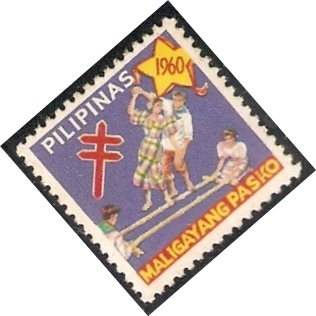
Philippine Native Dances
Figure 8 - 1960 Tinikling; Figure 9 - 1961 Pandango Sa Ilaw
Seal topics briefly shifted to the cultural and floral in the 1960s and early 1980s. The Japan-printed seals of 1960 and 1961 pictured the graceful native dances of “Tinikling” and “Pandanggo sa Ilaw” (Fig. 8 and Fig. 9).
Figure 10 - 1969 Sampaguita, National Flower, Types 1 and 2
The finely-drawn Sampaguita, the national flower (Fig. 10) and the rare Mindanao orchid, the Waling-waling, were the subjects of the 1969 and 1970 issues. The five different cultivated Mussaendas, each named after a former Philippine first lady, graced the seals of 1982.
Figure 11 - 1986 Slice of Life by Larry Alcala
Printed by Kyodo, Novaliches, Quezon City; 1,000 round perforated sheets
The 1986 se-tenant sheet provided a refreshing change from the sober themes of previous years. Drawn by the foremost cartoonist Larry Alcala, in his characteristic light wit and banter, the layout is an assembly of “slice of life” vignettes, showing rustic folks, with their foibles and provincialisms, celebrating Christmas and the New Year. (Fig. 11)
Directions for seal designs were verbalized in 1987. Concept statement suggested that seal designs follow a “national orientation – which a Pilipino would take pride in, to own, show and send to friends abroad.” Thus the seal sheet of that year depicted a pleasant se-tenant mix of native sceneries, dances, fruits, festivals and old transportation.
Figure 12 - 1989 Fiesta Islands
Printed by Industrial Offset, Marikina, Metro Manila; 129,000 perforated sheets
The 1989 sheet was another direct offshoot of this direction. In delicately crafted illustrations, it showcased ten native festivals and rituals of the “Fiesta Islands”. (Fig. 12)
The 1990 design portrayed six indigenous ritual dances, some tribal, captioned with original names, the “banga”, “sakuting’, “dugsa”. “maglalatik” and “binasuan”. Incidentally,. this issue pioneered the inclusion of free raffle tickets as part of the sheet. There were a first and a second printing, with major differences between printings.
In the late 1990s, themes dwelt more strongly on nationalism and love of country. Seal designs extolled “the Filipino stalwarts who contributed most significantly, during the last century , to the enhancement of Philippine independence and nationhood.” Honored with portrayals in the seal sheets of those years, se-tenant with other designs, were Pilipino greats – Andres Bonifacio, Apolinario Mabini, Marcelo H. del Pilar, Macario Sakay, Jose Abad Santos, Jose P. Laurel, Benigno Aquino, Chino Roces and a host of other revered personalities.
The year of the painting series was ushered in in 2000, when the multi-awarded versatile international painter-sculptor Manuel Baldemor consented to have forty of his artworks reproduced free to form the colorful se-tenant sheet of that year. This was repeated when forty other art pieces of Baldemor were likewise featured in the 2003 seal sheet.
Figure 13 - 2002 Christmas in the Philippines Including Paintings by Five National Artists
Printed by Lawrian Press Corporation, Quezon City
This highly appreciated painting designs continued through 2001, 2002 and 2004. Thru the influence and indefatigable efforts of Baldemor, almost a hundred of the most prestigious contemporary Pilipino painters, plus the heirs of some, were persuaded to lend their works to compose the seal sheet designs for those three years. Five of the donors in this distinguished group are National Artists for the Visual Arts: Victorio Edades, Vicente Manansala, Carlos “Botong” Francisco, Cesar F. Legaspi and Ang Kiukok. (Fig. 13)
C. CLASSIC STAGES / PHASES OF COLLECTION
To make collections historically and philatelically meaningful, many collectors endeavor to present the seal collected in the three basic stages or phases of its life, as follows:
1. The material in unused or “mint’ condition;
2. The material during production; and
3. The material in normal use.
As much as possible, the mint or unused seal should be in sound condition – no damage to paper, separation or color. Some collectors require original gum, others do not care too much ( ! ). If included in the regular issuance, the imperforate of the seal and the souvenir sheet are collateral members in this phase. If no souvenir sheet was issued, the single die proof may replace this material.
Samples of the material taken from the production stage would include separation and printing errors, essays if any, color separation and progressive color proofs proofs and proof runs. Some interesting printers’ waste are also collectible.
The “excitement of the chase” heightens during this stage. Some proofs, essays, unusual errors and other production oddities are often difficult to come by. But these provide the “icing on the cake” so to speak, and will test the mettle and ingenuity of the collector in locating and securing the prize item.
Postal usage is the final stage in the life of the collected seal. Because seals have no franking value, they have to be paired with postage stamps, and incidentally immensely brighten the mail during the Christmas season. It is important that the postmark or postal cancellation “ties” both the seal and the stamp to the cover. A preferred used cover is one with postmark clearly showing place and date of usage. A clean backstamp reinforces proof of usage and enhances desirability of the cover.
Figure 14 - Unusual Cover - Philippines to Saudi Arabia
1986 Seal tied on cover with handstamped Pasay Central postmark,
and with Jeddah backstamp inadvertently struck on front
Figure 15 - 1988 Seal without postage stamp tied cover with postal meter (Manila to Connecticut, USA)
There are three types of postal cancellations: hand-stamped, machine-cancellation and postal meter (Fig. 14). There are occasions when mail is posted with a seal but without a postage stamp. If machine-cancelled, or cancelled with a postal meter, this becomes a valid and highly collectible cover. (Fig. 15)
Figure 16 - 1929 U.S. NTA Seal tied on cover with Philippine postmark (Manila to Illinois, USA)
There is a not too well-known sidelight regarding Philippine seal covers. In 1917, the Philippine Tuberculosis Society was appointed by the American National Red Cross and the American Association for the Study of TB to be their representative for the sale of U.S. Red Cross, and later of U.S. NTA seals in the Philippines. This arrangement presumably continued up to the outbreak of WW II. Thus, US Red Cross and NTA seals were “officially” sold and used in the Philippines from 1917 to 1941. US seals of these years properly tied on cover with Philippine postmarks, whether domestic or sent abroad are now scarce finds that command a considerable price. (Fig. 16)
D. RARITIES / SCARCITIES
The goal of every collector is to complete his collection in the manner he prefers. Some aspire for no more than having a representative seal “from first to last” in the order of chronological issuance.
Some might later view this as too staid and clinical, and would now and then add a few tied-on covers as he finds them. These new additions begin to infuse life into the collection.
The more curious and intrepid collector would further expand this accumulatio0n. Little by little, the collector would acquire some needed complementing, but more difficult to find items. These might include seldom-seen proofs, essays, astonishing errors, and even the originals of the first seals.
The following rare / scarce materials would considerably upgrade the beauty and value of the collection:
1. The first three seals issued
Figure 17 - 1946 tete-beche Sheetlet of Six (The Philippine Tuberculosis Society)
The 1910 Rizal, the 1935 Quezon strips in blue and brown types and the 1946 maverick seals – are definite rarities. The 1946 seal, in the original sheetlet of six seals in tete-beche format with gutters between, may well be one of the rarest of Philippine seals. (Fig. 17) (These first three seals were reprinted in the 1985 main sheet and souvenir pane, and could be cut out to serve as space fillers until the originals are obtained.)
2. Tied on Covers
We have heard of some very lucky collectors owning any of these first seals cleanly tied on cover. These are extreme rarities. Even the early Republic seals properly tied on cover could be appraised ten-fold or even much more over the value of the seal.
3. Errors, Freaks and Oddities
Figure 18 - 1998
Seal Sheet Error - Massive Shifts of red and blue
Errors are production accidents, some of which can really be amazing. Among outstanding seal errors are those with: inverted or missed colors or overprints, deep and long multiple accordion folds, missed printing due to paper fold, double impression of one or two colors, wide color or separation shifts, freak or missing perforations or roulettes and countless others. Availability would range from limited to rare. (Fig. 18)
4. Essays
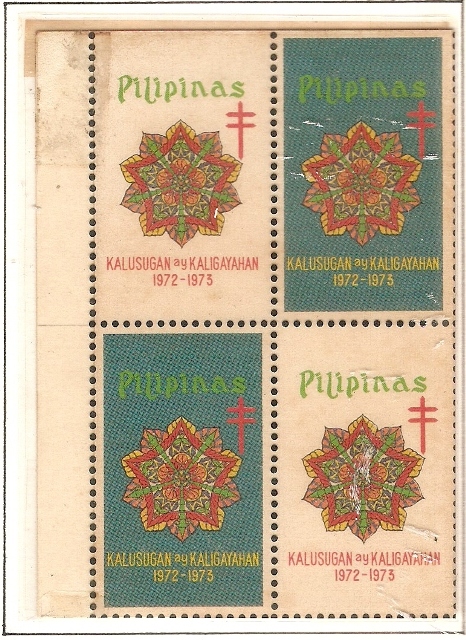
Figure 19 - 1972 Enlarged Essay with Normal Copies for Comparison
The enlarged essay of 1972, about twice the size of the regular seals, surfaced only in 1985. Only one sheet of 8 x 5 seals was ever found. Extremely scarce. (Fig. 19)
5. Early Single Die Proofs
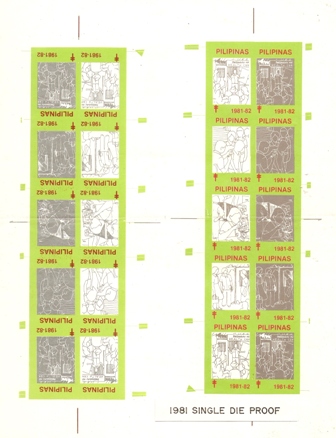
Figure 20 – 1981 and 1982 single die proofs
The single die proofs of 1950 (two varieties), 1951 and 1953 have always been hard to find. These were available among US seal dealers up to a few years ago, but not any more. The Republic single dies of 1981 and 1982 are probably scarcer. Only a few copies of these were made, but not issued. (Fig. 20)
6. Rejected Single Die Proofs
The approved 1985 single die proof, including the rejected ones, are equally elusive. The trial single die proof on scrap paper, with the Quezon seals smaller than actual, and the TB cross inside the 1946 seal in black, instead of red , is a rarity.
7. 1985 Essay No. 1
Figure 21 - 1985 Essay No. 1
Possibly only four complete sheets were printed of the 1985 Essay No. 1, with the center seal slogan reading “Brighten your mails with SEALS this Christmas” instead of the regular “For a healthier community, let’s fight TB”. (Fig. 21). Some varieties, all with the Rizal green not yet printed, are just slightly less difficult to find.
8. 1985 Essay No. 2
Figure 21a - 1985 Essay No. 2
Similarly, perhaps only a very few complete sheets were made of the 1985 Essay No. 2, with center seal slogan “For a healthier community, let’s fight TB” in black instead of the regular red. Likewise, there are varieties, all with the Rizal green missing, that are just slightly easier to find.
9. The Progressive Color Proofs
The progressive color proofs of 1947, 1979 and 1984 are extra-scarce. Of the 1947 PCP, one US dealer quipped, “I know they exist, but I have not seen any.” The 4-stage 1977 and the multi-stage 1984 PCPs were unissued and were only scrounged from printers’ waste.
10. 2004 Essay No. 1
Figure 22 - 2004 Essay No. 1
The 2004 essays are of recent vintage but are already extremely scarce. Essay No. 1, in experimental dark pink background color, is a color separation proof, where the painting on seal frame no. 9 was replaced with another at the last minute. The regular sheets were subsequently printed with yellow background and with the replacing frame. Only seven or eight copies of this essay were printed. A one-of-a-kind 7-stage PCP of this essay was also made.
11. 2004 Essay No. 2
The 2004 Essay No. 2 is almost identical with Essay No. 1, except that its background color is yellow. Also only seven or eight copies of this were made., no PCPs.The rarities are the jewels that crown the collection and make it distinctive over others. They endow the collection with color, drama – and intrinsic value, and the collector with that glowing feel of fulfillment.
The collection is just comparatively completed but not closed. It shall remain open, receptive of new wondrous finds.
